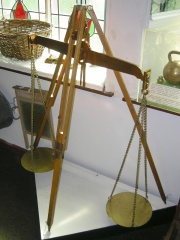De Grave


De Grave & Co of London
c.1767 Charles De Grave went into business making weights and balances.
He continued in business until his death in 1799[1]
1799 His wife, Mary, took over the business, and continued to run it until 1844, using her name and description 'widow of Charles De Greve' on the products.
1802 Partnership dissolved. '...the Partnership heretofore carried on by Charles De Grave and John Sawgood, of St. Martin's-le-Grand, London, Beam and Scale-Makers, is dissolved by mutual Consent; and all Debts now due and owing to the said Concern are to be paid to Richard Wood, of Queen-Street, Cheapside, London, Beam and Scale Maker, John Wainer, of the Crescent, Jewin-Street, London, Brass-Founder, and Joseph Bitterton, of Aldersgate Street, London, Brass-Founder, to whom the said Debts are duly assigned:...'[2]
1806 Charles and Mary’s son Edward was apprenticed to the business
1814 Listed as 'De Grave Mary, Scale and Weight Maker, 59 St Martin's-Le-Grand'[3]
From 1817 to 1844 the business was known as De Grave and Son, at 59 St Martin's-le-Grand.
1827 Mentioned. 'Messrs. Mary De Grave and Son' re the new standard weights and measures.[4]
1834 Bill. Mary De Grave and Son, scale makers, for brass weights and measures.[5]
1840 Advertisement. M. De Grave and Son announce that all the scales in Post Offices in the UK are made by them. Of 59 St Martin's-le-Grand.[6]
1844 Mary De Grave was succeeded by her son, Charles.
From 1845 the business was De Grave, Short and Co, and then De Grave, Short and Fanner
By 1851 William Fanner, scale maker, was living at 59 St Martins with his family[7]
1851 De Grave, Short and Fanner exhibited at the Great Exhibition
After William Fanner's death, the business reverted to the De Grave, Short and Co name.
1890 the address was 13 Farringdon Road.
1922 The firm became part of the Avery organisation[8]
1925 Averys acquired L. Oertling
1934 Albert William Harrington joined De Grave Short, Peckham, as a trainee in Small Beams
1935 Harrington moved to the Oertling section; fast progress to foreman in balance assembly.
1942 Harrington began making balances in his garden shed. At some unknown date this grew into commercial making, selling through H. M. Stanley. He was still employed at Oertling.
c.1946 Left Oertling; Harrington was by then foreman in fine balance repairs at No. 23 Charterhouse Street, beneath the De Grave Short showroom. With Henry Morton Stanley he set up Stanton Instruments Ltd.
See Also
Sources of Information
- ↑ Nineteenth-century Scientific Instruments by Gerard L'Estrange Turner
- ↑ The London Gazette Publication date:5 June 1802 Issue:15486 Page:586
- ↑ 1814 Post Office Directory
- ↑ Stamford Mercury - Friday 27 April 1827
- ↑ National Archives
- ↑ Morning Chronicle - Wednesday 22 January 1840
- ↑ 1851 census
- ↑ [1] GEC history page on website of Robert Cutts

